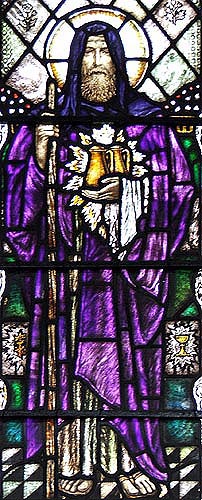 |
 |
|||
|
|
Joseph of Arimathea was a wealthy disciple of Jesus, who, according to the book of Matthew 27:57-60, asked Pontius Pilate for permission to take Jesus' dead body in order to prepare it for burial. He also provided the tomb where the crucified Lord was laid until his Resurrection. Joseph is mentioned in a few times in parallel passages in Mark, Luke and John, but nothing further is heard about his later activities. Apocryphal legend, however, supplies us with the rest of his story by claiming that Joseph accompanied the Apostle Philip, Lazarus, Mary Magdalene & others on a preaching mission to Gaul. Lazarus & Mary stayed in Marseilles, while the others travelled north. At the English Channel, St.Philip sent Joseph, with twelve disciples, to establish Christianity in the most far-flung corner of the Roman Empire: the Island of Britain. The year AD 63 is commonly given for this "event", with AD 37 sometimes being put forth as an alternative. It was said that Joseph achieved his wealth in the metals trade, and in the course of conducting his business, he probably became acquainted with Britain, at least the south-western parts of it. Cornwall was a chief mining district and well-known in the Roman empire for its tin. Somerset was reknowned for its high quality lead. Some have even said that Joseph was the uncle of the Virgin Mary and therefore of Jesus, and that he may have brought the young boy along on one of his business trips to the island. Hence the words of Blake's famous hymn, Jerusalem:
It was only natural, then, that Joseph should have been chosen for the first mission to Britain, and appropriate that he should come first to Glastonbury, that gravitational center for legendary activity in the West Country. Local legend has it that Joseph sailed around Land's End and headed for his old lead mining haunts. Here his boat ran ashore in the Glastonbury Marshes and, together with his followers, he climbed a nearby hill to survey the surrounding land. Having brought with him a staff grown from Christ's Holy Crown of Thorns, he thrust it into the ground and announced that he and his twelve companions were "Weary All". The thorn staff immediately took miraculous root, and it can be seen there still on Wearyall Hill. Joseph met with the local ruler, Arviragus, and soon secured himself twelve hides of land at Glastonbury on which to build the first monastery in Britain. From here he became the country's evangelist. Much more was added to Joseph's legend during the Middle Ages. He was gradually inflated into a major saint and cult hero, as well as the supposed ancestor of many British monarchs. He is said to have brought with him to Britain a cup, said to have been used at the Last Supper and also used to catch the blood dripping from Christ as he hung on the Cross. A variation of this story is that Joseph brought with him two cruets, one containing the blood and the other, the sweat of Christ. Either of these items are known as The Holy Grail, and were the object(s) of the quests of the Knights of King Arthur's Round Table. One legend goes on to suggest that Joseph hid the "Grail" in Chalice Well at Glastonbury for safe-keeping. There is a wide variance of scholarly opinion on this subject, however, and a good deal of doubt exists as to whether Joseph ever came to Britain at all, for any purpose. St. Joseph of Arimathea is recordeded in the New Testament. He is generally considred historic.
|
|||
| © Nash Ford Publishing 2001. All Rights Reserved. | ||||





 St.
Joseph of Arimathea
St.
Joseph of Arimathea